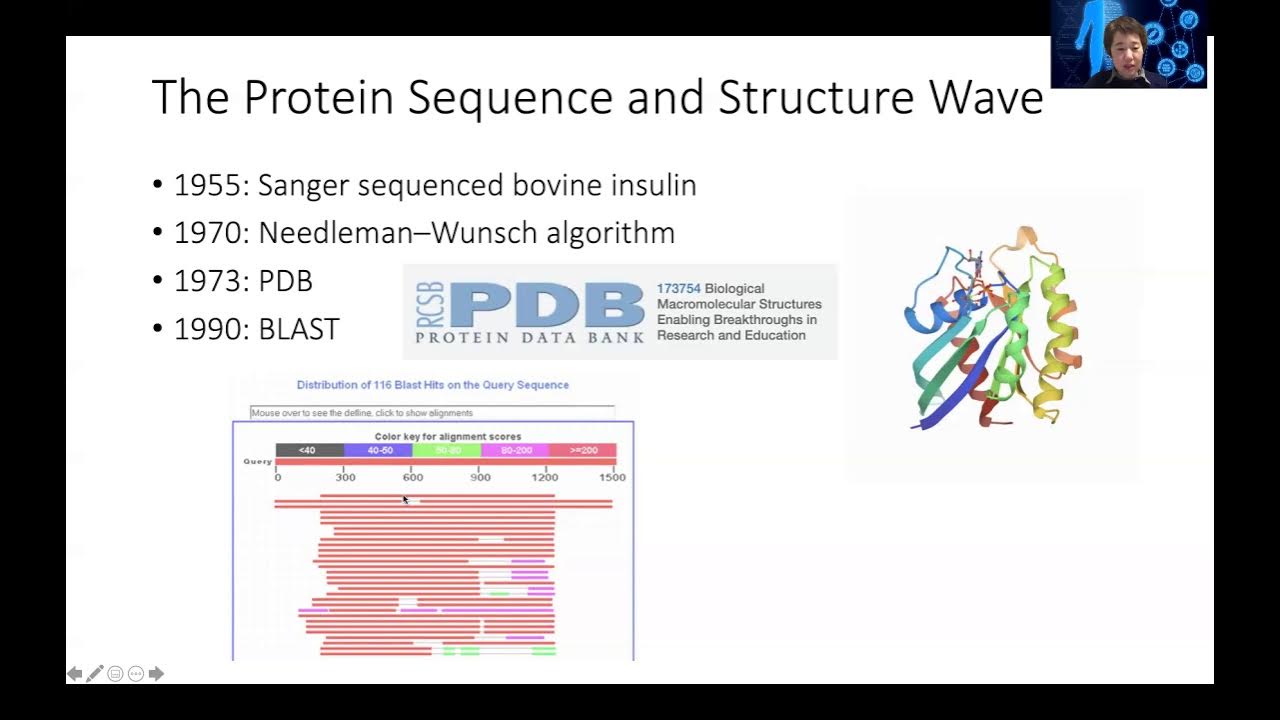Video11 Ch 3 Act 1part 2
Summary
TLDRThis educational video explores the fundamentals of protein structure and function. It begins by detailing the formation of dipeptides through a synthesis reaction between amino acids, resulting in a peptide bond. The script then delves into protein structures, distinguishing between primary, secondary, tertiary, and quaternary levels. It explains denaturation, the disruption of protein structure, and differentiates between functional and structural proteins. Examples like insulin and ribonuclease illustrate how amino acid sequence and configuration impact protein activity. The video concludes by emphasizing the importance of protein structure for function.
Takeaways
- 🔬 Proteins are characterized by a specific number of amino acids, the types of amino acids present, and their sequence.
- 🧬 Dipeptides are formed by a synthesis reaction where two amino acids join via a peptide bond, releasing a water molecule.
- 💧 Hydrolysis is the reverse of synthesis, breaking down proteins into amino acids in the presence of water.
- 🌡️ Denaturation alters a protein's 3D structure, potentially causing it to lose its function, without breaking the primary structure's peptide bonds.
- 🧬 The primary structure of a protein refers to the linear sequence of amino acids as encoded by DNA.
- 🌀 Secondary structures are formed by hydrogen bonds between the backbone atoms of amino acids, such as alpha helices and beta sheets.
- 🔋 Tertiary structure is the overall 3D configuration of a single polypeptide chain, which is crucial for protein function.
- 🤝 Quaternary structure occurs when multiple polypeptide chains come together to form a functional complex, like the four subunits of hemoglobin.
- 🏛️ Proteins can be classified as structural, forming the cell's framework, or functional, performing various cellular and systemic roles.
- 📊 The function of a protein is dependent on both the sequence of amino acids and its three-dimensional structure.
Q & A
What is the main focus of the lesson described in the transcript?
-The main focus of the lesson is to understand the formation of dipeptides, the characteristics of proteins, and the different levels of protein structures.
What is a dipeptide and how is it formed?
-A dipeptide is a molecule made up of two amino acids joined together. It is formed through a synthesis reaction where the hydroxyl group of the first amino acid bonds with the hydrogen atom of the amino group of the second amino acid, resulting in the formation of a water molecule and a peptide bond.
What is the reverse reaction of dipeptide formation called?
-The reverse reaction of dipeptide formation is called hydrolysis, where a dipeptide is broken down into two separate amino acids in the presence of water.
What factors determine the functionality of a protein?
-The functionality of a protein is determined by the sequence of amino acids and its three-dimensional structure, which includes the primary, secondary, tertiary, and quaternary levels.
How does the sequence of amino acids affect protein function?
-The sequence of amino acids determines the protein's distinct shape and chemical characteristics, which are crucial for its function. For example, insulin's function is affected by the presence or absence of the C chain in its pro-insulin and insulin forms.
What is denaturation and how does it affect protein structure?
-Denaturation is the disruption and possible destruction of the secondary and tertiary structures of a protein, without affecting the primary structure. This can lead to a loss of protein function due to changes in its 3D configuration.
What are the four levels of protein structure?
-The four levels of protein structure are primary (linear sequence of amino acids), secondary (folds like alpha helix and beta sheets), tertiary (3D structure), and quaternary (structure formed by multiple polypeptide chains).
What is the difference between functional and structural proteins?
-Functional proteins perform specific functions at cellular and systemic levels, such as enzymes and hormones, while structural proteins form the structure of the cell, like collagen in the skin and keratin in the hair.
How does the folding of a protein chain contribute to its secondary structure?
-The folding of a protein chain into secondary structures like alpha helix and beta sheets is stabilized by hydrogen bonds, which contribute to the protein's stability and function.
Can you provide an example of a protein that relies on its folded structure for function?
-Hemoglobin is an example of a protein that relies on its folded structure to form a pocket that holds heme, allowing it to bind oxygen and transport it throughout the body.
Outlines

This section is available to paid users only. Please upgrade to access this part.
Upgrade NowMindmap

This section is available to paid users only. Please upgrade to access this part.
Upgrade NowKeywords

This section is available to paid users only. Please upgrade to access this part.
Upgrade NowHighlights

This section is available to paid users only. Please upgrade to access this part.
Upgrade NowTranscripts

This section is available to paid users only. Please upgrade to access this part.
Upgrade NowBrowse More Related Video
5.0 / 5 (0 votes)





